Pu Erh Tea and Its Role in Traditional Chinese Medicine
Pu Erh tea has played a crucial role in Traditional Chinese Medicine (TCM) for centuries. You'll find its roots deeply entrenched in ancient Chinese medical practices, dating back over 2,000 years.
In TCM, Pu Erh tea is classified as a "warm" and "yang" substance. This classification means it's believed to promote circulation and boost metabolism. Traditional practitioners have long recommended it for various health concerns.
Some key historical uses of Pu Erh tea in Chinese medicine include:
Bestsellers

2022 Pu-Erh Tea Sample Box (Free Shipping)

2022 Yi Pin Chen Sheng Raw Pu-erh Tea Sample Box

2022 Lao Ban Zhang Raw Pu-erh Tea

2022 Na Ka Raw Pu-erh Tea

2023 Ban Zhang Yin Xiang Raw Pu-erh Tea

2017 Rong Pu Ripe Pu-erh Tea
- Aiding digestion
- Promoting weight loss
- Reducing blood lipids
- Detoxifying the body
- Improving mental alertness
During the Tang Dynasty (618-907 AD), Pu Erh tea gained significant popularity as a medicinal beverage. It was often prescribed by imperial physicians to treat digestive issues and hangovers among the nobility.
The tea's reputation grew further during the Ming Dynasty (1368-1644 AD). It became a valuable trade commodity along the Ancient Tea Horse Road, connecting Yunnan to Tibet and beyond.
Pu Erh's unique fermentation process, which can last for years or even decades, is believed to enhance its medicinal properties. This aging process is thought to increase the tea's antioxidant content and beneficial microorganisms.
Today, Pu Erh tea continues to be valued in TCM. Modern research is exploring its potential health benefits, building upon centuries of traditional use and knowledge.
Discover our best-selling raw Pu Erh tea and elevate your tea experience today!
Classification of Pu Erh Tea

Pu Erh tea is categorized into two main types based on the production process and aging method. Each variety offers distinct flavors and health benefits.
Raw Pu Erh (Sheng)
Raw Pu Erh, also known as Sheng, undergoes minimal processing. After harvesting, the tea leaves are quickly dried and compressed into cakes or bricks. This type of Pu Erh is left to age naturally over time.
As it matures, Raw Pu Erh develops complex flavors, ranging from floral and fruity to woody and earthy. The taste can be quite astringent when young but mellows with age.
You'll find that Raw Pu Erh is highly prized by tea connoisseurs for its ability to improve with time. Many collectors age their Raw Pu Erh for decades, allowing it to develop unique characteristics.
Ripe Pu Erh (Shou)
Ripe Pu Erh, or Shou, undergoes an accelerated fermentation process. The tea leaves are piled, moistened, and regularly turned to encourage microbial activity. This process mimics years of natural aging in just a few months.
The result is a tea with a deep, dark color and a smooth, earthy flavor. Ripe Pu Erh often has notes of wood, leather, and sometimes a hint of mushroom.
Lao Ban Zhang

2024 Lao Ban Zhang Ripe Pu-erh Tea

2022 Lao Ban Zhang Raw Pu-erh Tea

2023 Ding Feng- Lao Ban Zhang Raw Pu-erh Tea (42g)

2024 Xiao Ban Zhang Raw Pu-erh Tea

2020 Lao Ban Zhang Raw Pu-erh Tea 125g
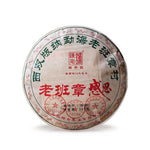
2025 Lao Ban Zhang -Gan En Raw Pu-erh Tea 357g
You'll appreciate Ripe Pu Erh for its mellow taste and lack of astringency. It's an excellent choice for those new to Pu Erh tea, as it's generally more approachable than its raw counterpart.
Both types of Pu Erh continue to change over time, offering a dynamic tasting experience as they age.
Preparation and Consumption Methods
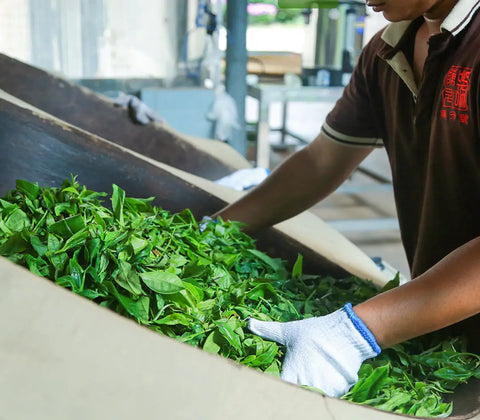
Pu Erh tea offers diverse brewing methods and consumption practices, blending traditional techniques with modern approaches.
Traditional Brewing Techniques
Gongfu tea ceremony is a classic method for preparing Pu Erh. You'll need a small clay teapot, cups, and a tea tray. Rinse the tea leaves briefly with hot water to awaken their flavors.
Use water at 95-100°C (203-212°F) for optimal extraction. Steep the leaves for 10-30 seconds, increasing steeping time with each infusion. This method allows you to experience multiple infusions, each revealing different nuances of the tea.
For a simpler approach, you can brew Pu Erh in a large teapot or mug. Use 1-2 teaspoons of leaves per cup and steep for 3-5 minutes.
Modern Consumption Practices
Cold brewing has gained popularity for Pu Erh. Add tea leaves to room temperature water and refrigerate for 8-12 hours. This method produces a smooth, less bitter taste.
Pu Erh tea bags offer convenience for on-the-go consumption. Simply steep in hot water for 3-5 minutes.
Some enthusiasts incorporate Pu Erh into smoothies or baked goods for its earthy flavor and potential health benefits. Experiment with adding it to your favorite recipes.
Pu Erh tea shots have emerged as a trendy way to consume the tea. Brew a concentrated amount and drink it as a quick energy boost.
Active Compounds in Pu Erh Tea
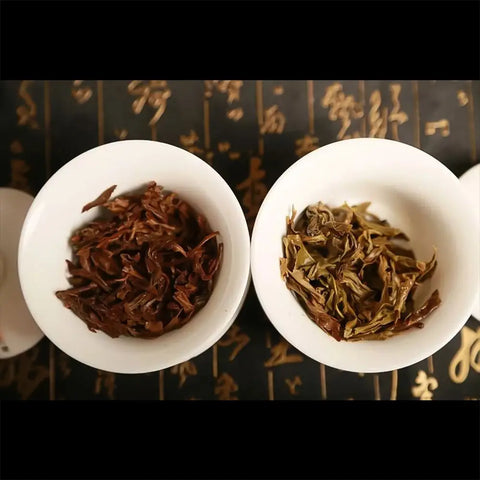
Pu Erh tea contains a variety of bioactive compounds that contribute to its unique flavor profile and potential health benefits. These compounds undergo changes during the fermentation process, resulting in a complex chemical composition.
Catechins and Thearubigins
Pu Erh tea is rich in catechins, particularly epigallocatechin gallate (EGCG). These powerful antioxidants help protect your cells from damage caused by free radicals. During fermentation, catechins transform into thearubigins, giving the tea its characteristic dark color and robust flavor.
Thearubigins may offer potential health benefits, including improved cardiovascular health and reduced inflammation. Research suggests that these compounds might help lower cholesterol levels and support healthy blood sugar regulation.
Caffeine Content
Pu Erh tea contains moderate amounts of caffeine, typically less than black tea but more than green tea. The caffeine content can vary depending on the specific type and processing method.
A cup of Pu Erh tea may contain 30-70 mg of caffeine, providing a gentle energy boost without the jitters often associated with coffee. The caffeine in Pu Erh tea is released more slowly into your bloodstream, resulting in a sustained and balanced alertness.
Microbial Fermentation Products
The unique fermentation process of Pu Erh tea involves specific microorganisms that produce various beneficial compounds. These include:
- Statins: Naturally occurring compounds that may help lower cholesterol levels
- Gallic acid: A potent antioxidant with potential anti-inflammatory properties
- GABA (gamma-aminobutyric acid): A neurotransmitter that promotes relaxation
The microbial activity during fermentation also creates small peptides and free amino acids, which contribute to the tea's distinctive flavor and aroma. These compounds may offer additional health benefits, such as improved gut health and enhanced immune function.
Health Benefits According to TCM
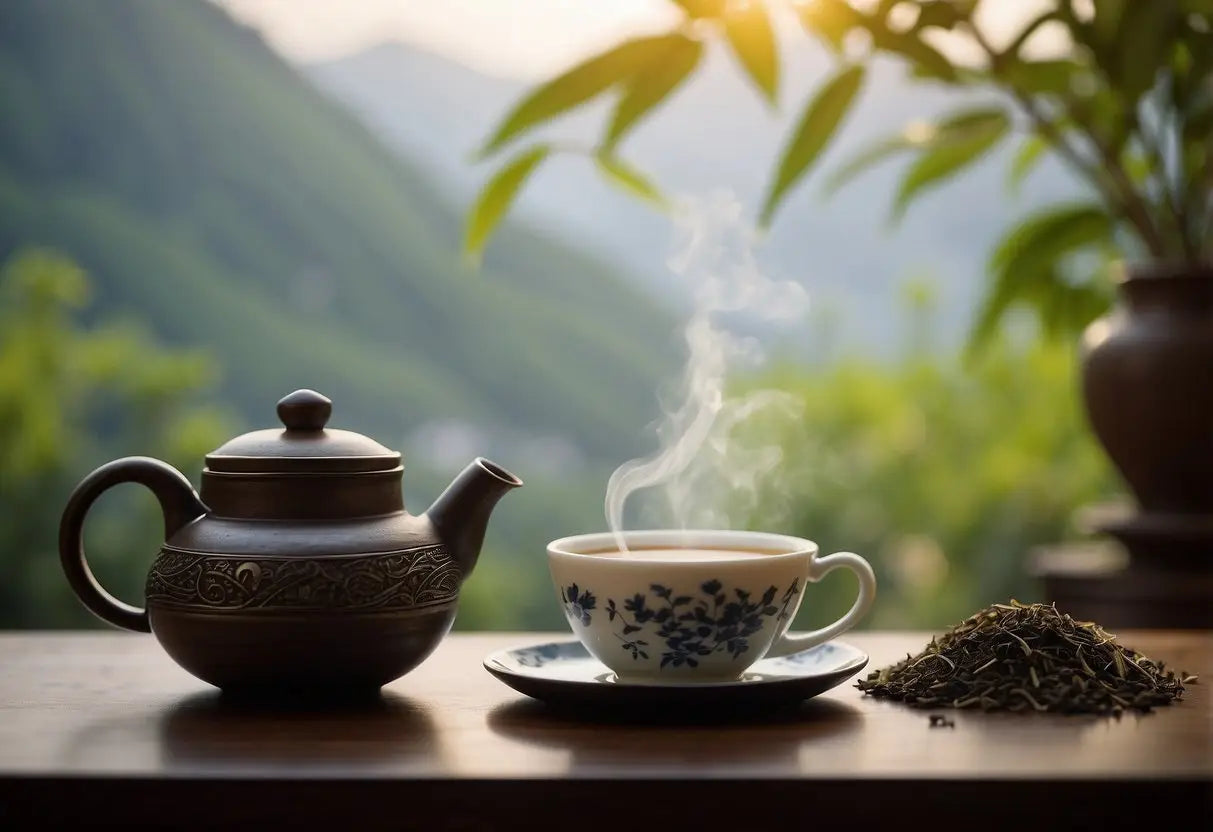
Traditional Chinese Medicine (TCM) attributes numerous health benefits to Pu Erh tea. Its unique properties are believed to support various aspects of well-being, from digestion to heart health.
Digestive Support and Weight Management
Pu Erh tea is thought to aid digestion and promote weight management in TCM. It's believed to stimulate the production of digestive enzymes, helping break down food more efficiently. This may lead to improved nutrient absorption and reduced bloating.
TCM practitioners often recommend Pu Erh tea to support metabolism and fat burning. The tea is said to activate the spleen and stomach, organs associated with digestion in TCM. This activation may help reduce the accumulation of excess fat in the body.
Some studies suggest that regular consumption of Pu Erh tea might contribute to modest weight loss, though more research is needed to confirm these effects.
Cardiovascular Health Promotion
In TCM, Pu Erh tea is associated with promoting cardiovascular health. It's believed to help lower cholesterol levels and reduce the risk of heart disease. The tea's compounds may support the proper functioning of blood vessels and improve circulation.
Pu Erh tea is thought to have a positive impact on blood pressure regulation. TCM practitioners often recommend it as part of a holistic approach to maintaining heart health.
Some research indicates that Pu Erh tea may help reduce LDL cholesterol levels while increasing HDL cholesterol, but further studies are needed to establish these benefits conclusively.
Detoxification and Anti-Inflammatory Effects
TCM views Pu Erh tea as a potent detoxifying agent. It's believed to support the liver's natural cleansing processes, helping remove toxins from the body. This detoxification is thought to contribute to overall health and vitality.
The tea is also valued for its potential anti-inflammatory properties. In TCM, inflammation is often seen as a root cause of many health issues. Pu Erh tea's compounds may help reduce inflammation throughout the body.
Some studies suggest that Pu Erh tea's polyphenols and other bioactive compounds might have antioxidant effects. These properties could potentially protect cells from damage caused by free radicals.
Pu Erh Tea and Qi Energy Balance
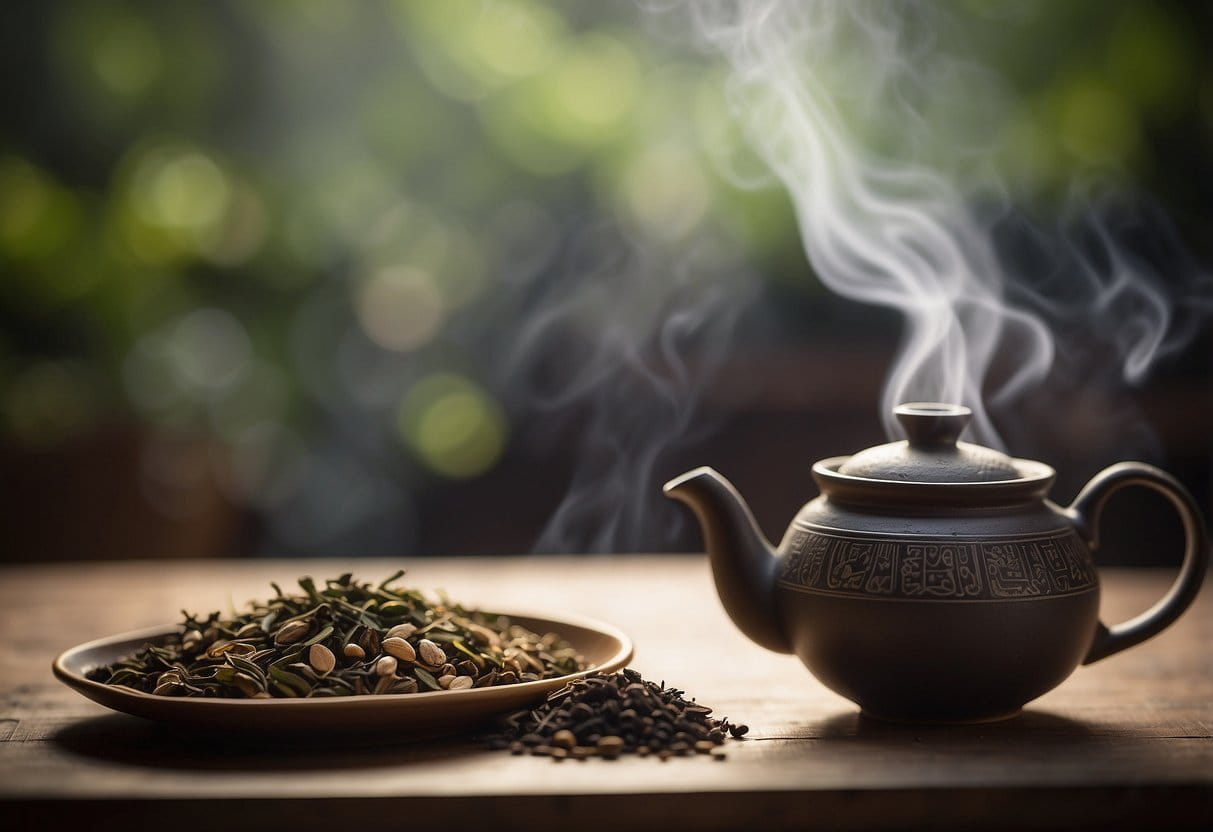
In Traditional Chinese Medicine (TCM), Pu Erh tea is believed to influence the balance of Qi energy in your body. Qi, the vital life force that flows through all living things, plays a crucial role in maintaining health and wellbeing.
Pu Erh tea is thought to help regulate Qi flow, particularly in the spleen and stomach meridians. By drinking this tea, you may experience improved digestion and enhanced nutrient absorption.
TCM practitioners often recommend Pu Erh tea to:
- Boost energy levels
- Promote circulation
- Support digestive health
- Balance internal heat
The tea's earthy flavor and warming properties are said to nourish your body's Yin energy while invigorating Yang. This balance is essential for optimal health in TCM philosophy.
Regular consumption of Pu Erh tea might help you:
- Maintain a harmonious Qi flow
- Support your body's natural healing processes
- Enhance overall vitality
It's important to note that while many people find Pu Erh tea beneficial, individual experiences may vary. Consulting with a qualified TCM practitioner can help you determine if Pu Erh tea is suitable for your specific health needs and Qi balance.
Dosage and Daily Consumption Recommendations
Pu Erh tea consumption varies based on individual needs and health goals. For general wellness, start with 1-2 cups (240-480 ml) per day. You can gradually increase this to 3-4 cups if desired.
Brewing strength affects dosage. Use 3-5 grams of tea leaves per cup of water for a standard brew. Steep for 2-3 minutes initially, increasing steeping time with subsequent infusions.
For weight management, consider drinking a cup 30 minutes before meals. This may help promote feelings of fullness and support digestion.
If using Pu Erh for cholesterol management, aim for 2-3 cups daily. Consistency is key for potential long-term benefits.
Caution: Pu Erh contains caffeine. Limit intake in the evening to avoid sleep disruptions. If you're sensitive to caffeine, start with smaller amounts and monitor your body's response.
Pregnant or nursing women should consult a healthcare provider before consuming Pu Erh regularly. The same applies if you have any pre-existing medical conditions or take medications.
Remember to stay hydrated throughout the day. While Pu Erh can contribute to your fluid intake, it shouldn't replace water as your primary source of hydration.
Potential Side Effects and Considerations
While Pu Erh tea offers various health benefits, it's important to be aware of potential side effects and considerations. Some individuals may experience adverse reactions or interactions with medications.
Interactions with Medications
Pu Erh tea contains caffeine, which can interact with certain medications. If you take stimulants, antibiotics, or blood thinners, consult your doctor before consuming Pu Erh tea regularly.
Caffeine in Pu Erh may increase the effects of stimulant medications, potentially causing jitters or anxiety. It can also interfere with the absorption of some antibiotics, reducing their effectiveness.
For those on blood thinners, Pu Erh's vitamin K content may counteract the medication's effects. Monitor your intake and discuss it with your healthcare provider.
Allergic Reactions and Sensitivities
Some people may experience allergic reactions to Pu Erh tea. Watch for symptoms like itching, hives, or difficulty breathing after consumption.
Individuals sensitive to caffeine might experience side effects such as:
- Insomnia
- Nervousness
- Increased heart rate
- Digestive discomfort
If you have a history of caffeine sensitivity, start with small amounts of Pu Erh tea and observe your body's response. Consider opting for decaffeinated versions if needed.
Those with iron deficiency anemia should be cautious, as tea can inhibit iron absorption. Try drinking Pu Erh between meals rather than with iron-rich foods.
Sourcing and Authenticity Concerns of Pu Erh Tea
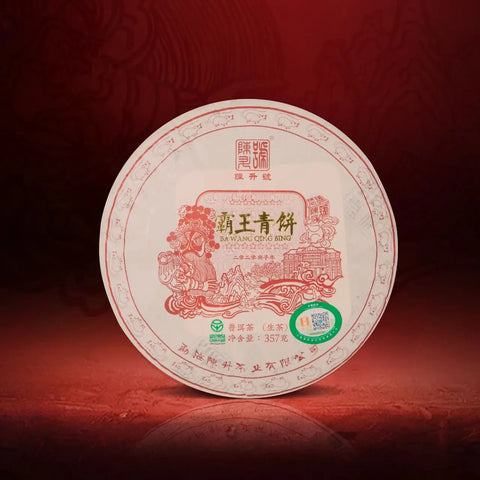
Pu Erh tea's quality and authenticity rely heavily on its origin and production methods. Proper sourcing and identification are crucial for ensuring you get genuine, high-quality Pu Erh tea.
Region-Specific Characteristics
Pu Erh tea originates from Yunnan province in China. The tea's unique characteristics are influenced by the specific terroir of its growing region. Teas from different areas within Yunnan have distinct flavor profiles and aging potential.
Notable Pu Erh producing regions:
- Xishuangbanna
- Simao (Pu'er City)
- Lincang
- Baoshan
Each region's climate, soil, and traditional processing techniques contribute to the tea's flavor, aroma, and aging potential. For example, Xishuangbanna Pu Erh often has a rich, earthy taste, while Lincang Pu Erh may have a more floral or fruity character.
Identifying High-Quality Pu Erh Tea
When selecting Pu Erh tea, consider these factors to ensure authenticity and quality:
- Appearance: Look for whole, intact leaves with a consistent color.
- Aroma: High-quality Pu Erh should have a pleasant, complex scent.
- Taste: The flavor should be smooth and well-balanced, without bitterness.
Reputable tea vendors often provide detailed information about the tea's origin, production date, and storage conditions. Be wary of suspiciously low-priced Pu Erh, as it may indicate poor quality or counterfeit products.
Authenticity indicators:
- Clear labeling of production region and date
- Proper storage and aging information
- Certification from recognized tea authorities
By familiarizing yourself with these characteristics, you can make informed decisions when purchasing Pu Erh tea and enjoy its authentic flavors and benefits.
← Older post Newer post →
